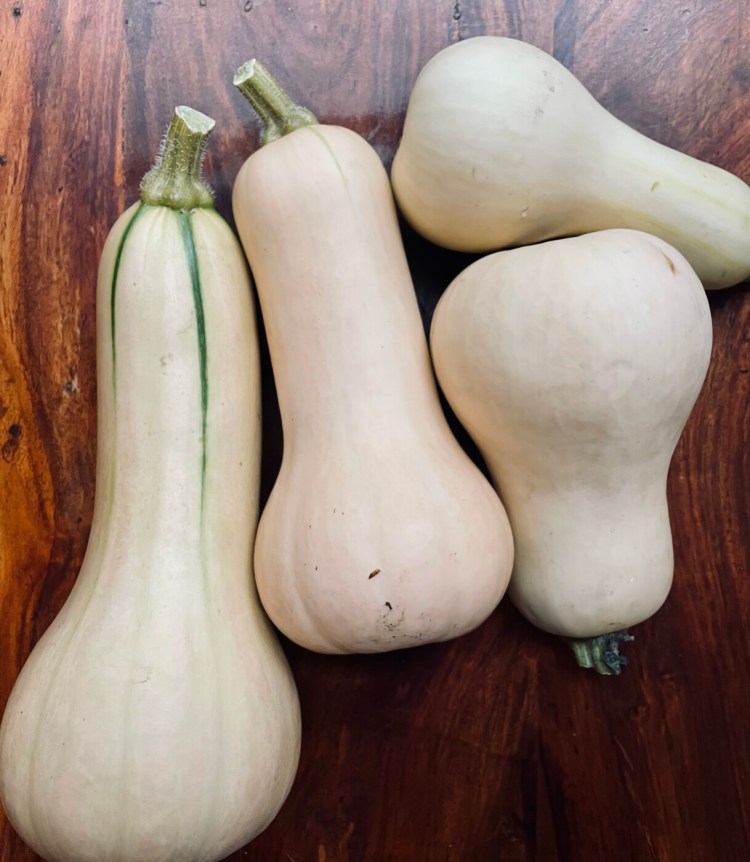Did you know you can eat under-ripe, immature butternut squash?
They are gourd-eous!
Kidding aside, knowing this fact can help reduce local food waste as Maine farmers and gardeners move forward with the winter squash harvest. Butternut squash typically is picked when the rind has hardened, and its color has turned from a stripey green and pale yellow to a deep, solid tan. In Maine, most of the crop matures on the vine until late September or early October to ensure the skins are thick enough for winter storage.
Ben Whatley of Whatley Farm in Topsham harvests butternuts before nighttime temperatures dip below 40 and definitely before the first frost. Squash harvested after frost will be sweeter but will not store as long as squash harvested before frost.
Both farmers and gardeners typically have some immature fruit in the field when most of the harvest is ready to pick. “We can plant them on time to get a good mature crop in the fall, but since healthy plants will keep setting fruit throughout the summer, we’ve always got some immature ones in the field,” Whatley said. When I had first emailed him to ask if he would sell me a few unripe butternuts (I possess few gardening skills), he’d never thought of eating them.
But he was game to have me experiment with several specimen from his fields. He presented me with a full-sized one that still had green stripes stretching from its stem and three smaller ones with various shades of pale yellow rind. While the skin of mature squash I will buy from Whatley later this fall will be dull and dry-looking, these immature squash skins had a bright sheen. You can easily scrape the skins with your fingernails, so they require a gentler touch than their older siblings. And they need to be stored in your refrigerator.
Because unripe butternuts are less sweet and more starchy than mature ones that have been cured (a 10-to-14-day process of simply letting the squash sit in a warm place with good air circulation so that it’ll store for longer), you simply treat them like potatoes. You can cut them into matchsticks and cook them in hot oil like French fries. You can shred them and sauté them with minced onion in butter like hash browns. Or you can bake them into your favorite gratin recipe as I did.

Immature Standup Squash Gratin is made with unripe butternut squash. Photo by Christine Burns Rudalevige
Immature Standup Squash Gratin

To cut the butternut squash, slice off the tops, peel the squash, slice it in half lengthwise and remove any seeds. Then lay each half on its flat side and slice as thinly as you can. Photo by Christine Burns Rudalevige
This recipe is adapted from one published for Hasselback potato gratin by food science writer J. Kenji López-Alt. Hasselbacking, which originated at the Hasselbacken Hotel in Stockholm, Sweden, is a cooking method in which potatoes or other items are sliced not-quite-all-the-way through in thin, even layers, and stuffed or topped with additional flavorings. It is tough to slice a winter squash not-quite-all-the-way through, but you can stand the slices up on their sides as a way of creating more surface area for the starchy main ingredient to crisp up.
2 ounces finely grated alpine-style cheese
2 ounces local cheddar cheese
2 ounces finely grated Parmigiano-Reggiano
2 cups half & half
½ cup crème fraîche
2 medium cloves garlic, minced
1 tablespoon fresh thyme leaves, chopped
1½ teaspoons kosher salt
½ teaspoon black pepper
4 to 4½ pounds unripe butternut squash (4 small), peeled and sliced ⅛-inch thick
2 tablespoons unsalted butter, more for greasing the pan
Adjust the oven rack to the middle position and heat the oven to 400 degrees. Combine the cheeses in a large bowl. Transfer one-third of the cheese mixture to a separate bowl and set aside. Add the half & half, crème fraîche, garlic and thyme to the bulk of the cheese mixture. Season generously with salt and pepper. Add the squash slices and toss with your hands until every slice is coated with the cream mixture.
Grease a 2-quart baking dish with butter. Pick up a handful of squash slices, organizing them into a neat stack, and lay them in the casserole dish with their edges aligned vertically. Continue placing the squash slices in the dish, packing them tightly until none are left in the bowl. Pour the excess cream mixture evenly over the squash until it comes halfway up the sides of the casserole. You may not need all the excess liquid.
Cover the dish tightly with foil and slide it into the oven. Bake for 30 minutes. Remove the foil and continue baking until the top is pale golden brown, about 20 minutes longer. Carefully remove the gratin from the oven, sprinkle with the reserved cheese, and return the casserole to the oven. Bake until deep golden brown and crisp on top, 15 minutes longer. Remove the gratin from the oven, let it rest for a few minutes before serving.
Send questions/comments to the editors.



Success. Please wait for the page to reload. If the page does not reload within 5 seconds, please refresh the page.
Enter your email and password to access comments.
Hi, to comment on stories you must . This profile is in addition to your subscription and website login.
Already have a commenting profile? .
Invalid username/password.
Please check your email to confirm and complete your registration.
Only subscribers are eligible to post comments. Please subscribe or login first for digital access. Here’s why.
Use the form below to reset your password. When you've submitted your account email, we will send an email with a reset code.